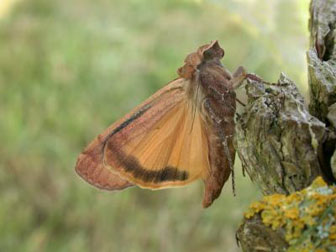Audible warfare: how moths avoid bats
Audible warfare: how moths avoid bats
mongabay.com
December 18, 2006
A new study published in Current Biology suggests bats and moths may be engaged in evolutionary warfare when it comes to their sense of hearing.
The new research, conducted by James Windmill and colleagues at the University of Bristol, shows that the ear of the yellow underwing moth changes its frequency (pitch) sensitivity in response to sound — specifically the ultrasonic calls of bats. The finding raises the question of whether bats “in turn modify their calls to avoid detection by moths.”
A University of Bristol news release describing the research appears below.
 The Yellow Underwing moth. Credit: Dr James Windmill |
University of Bristol: How to avoid a bat
New findings change our understanding of the co-evolution of bats and moths and have implications for the hearing of many other animals
Current understanding of the co-evolution of bats and moths has been thrown into question following new research reported today in Current Biology.
Dr James Windmill from the University of Bristol, UK, has shown how the Yellow Underwing moth changes its sensitivity to a bat’s calls when the moth is being chased. And in case there is another attack, the moth’s ear remain tuned in for several minutes after the calls stop.
Dr Windmill said: “Because the moth cleverly tunes its ear to enhance its detection of bats, we must now question whether the bat in turn modifies its calls to avoid detection by the moth. In view of the vast diversity of bat calls, this is only to be expected.
“To date, this phenomenon has not been reported for insects or, in fact, for any other hearing system in the animal kingdom. These findings change our understanding of the co-evolution of bats and moths and have implications for the hearing of many other animals.”
It has been known for over 50 years that moths can hear the ultrasonic hunting calls of their nocturnal predator, the bat. Previously it was thought that these ears were only partially sensitive to the sound frequencies commonly used by bats and that bats would make their hunting calls inaudible to moths.
But now it appears that even though moth ears are among the simplest in the insect world — they have only two or four vibration sensitive cells attached to a small eardrum — moths are not as deaf as previously thought.
As a bat gets closer to the moth, both the loudness and frequency (pitch) of the bat’s calls increase. Surprisingly, the sensitivity of the moth’s ear to the bat’s calls also increases. This occurs because the moth’s ear dynamically becomes more sensitive to the frequencies that many bats use when attacking moths.
This multidisciplinary work involved engineers, biologists and physicists; biological measurements are accompanied by a mathematical model explaining the basis for the unconventional behaviour of the moth’s ear.